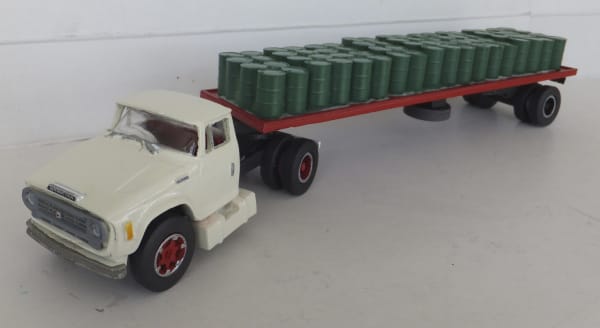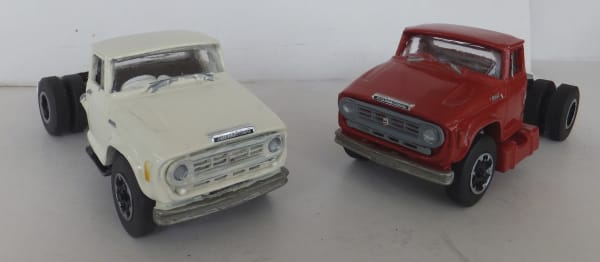The D-Line International was the last update of a cab design that originated in the U.S. in 1957, but was re-designed from the windscreen forward in 1962, to become unique to Australia.
Starting with the AB-Line from 1962, the cab was updated in 1967, with the introduction of the C-Line and, then in 1972, with the release of the D-Line, which ceased production in 1979.
Running changes were introduced at the beginning, and towards the end, of a production run, and included modifications such as re-designed doors with different door handles, during the D-Line run, and the combined clear parking light/blinker light lenses being changed to a lens with half amber for the blinker and the other half clear for the parking light, during the C-Line run.
During the production run of the D-Line trucks, other changes included the abolition of the separate parking light under the grille, when a combined headlight and parking light assembly was introduced, and the grille colour was updated from ‘Nullarbor Beige’ on early production models to ‘Granite Grey’ on later production vehicles.
Production of the International (AB, C and D-Line) and Dodge (AT4 and D5N) series was shared between the two makes, with Chrysler producing the cabs, and International supplying the chassis. Each supplied their own power plant
International D-Line
The D-Line range consisted of the D1310, D1410 (both equipped with the 142hp 6-281 petrol engine), D1610, D1710, D1810 (with the 177hp 345 V8 petrol), D1630, D1730, D1830 (with the 120hp Perkins 6-354 diesel), D1910 (212hp 392 V8 petrol), and D1950 with the Cummins C160 (464 cubic inch 160hp diesel).
Wheelbase options on the medium to heavy duty units included 171” and 189” for the D1610, D1630, D1710, D1730, and 153” and 171” for the D1810, D1830, D1910 and D1950.
Gearboxes ranged from the T-17 4 speed in the D1310 through to the T-401 5 speed with a 10 speed option. Models from D1310 to D1730 had a 4 speed gearbox as standard (5 speed optional for D1710), and a 5 speed gearbox was standard on D1810 through to D1950. D1310, D1410 and D1610 were available as a 4x4, and D1710 through to D1950 had a two speed rear axle.

Standard Equipment and Anomolies
A different model identification system was introduced with the release of the ACCO-A and was carried through to the D-Line, whereby ‘10’ signified a petrol engine, ‘30’ signified a 6 cylinder diesel, and ‘50’ signified a V8 diesel. However, for the D-Line, to avoid complication, a ‘10’ represented any petrol engine (for example a D1310 or D1910), ‘30’ represented the Perkins 6-354 (such as the D1830) and ‘50’ was reserved for the Cummins 160 (found in the D1950).
There is at least one example of a D1910 with a factory fitted Detroit 6V53N and T-488 transmission, as stamped on the ID tag, so there were exceptions to these rules and, of course, there were the custom ordered trucks that didn’t comply to the norm.
Previously, standard equipment engines for the
C-Line and ACCO butter box range of trucks were represented by ‘00’ or ‘20’ for a petrol six (for example a C1600 or C1820), ‘40’ for a petrol V8 (such as a C1840), and ‘50’ for a diesel V8 (like the C2150). A diesel engined version was given a ‘D’ prefix (the CD1840, for example) which made the last two digits simply representative of a light, medium or heavy duty load capacity. This system was simplified by abolishing the ‘D’ and introducing the designations ‘30’ or ‘50’ instead.


About The models
The models featured in this article are 1:43 (’O’ gauge) scale, and are handbuilt, handpainted, and made in Australia.
The combined prime mover and trailer measures 330mm in length. The prime mover can be ordered in any colour until production is discontinued, as production numbers are very low. Standard issue for the trailer (until production is discontinued) is a single axle trailer with a load of Castrol green oil, however, a load of Ampol blue drums may be subject to availability.
A white external sunvisor is optional.
Each model is, therefore, created as a ‘special order’ to your requirements.
For information, prices and availabilty:
Rob‘s Classic Models
website: robsclassicmodels2.webs.com
email: robsclassicmodels@gmail.com
write to: Rob’s Classic Models,
PO Box 65, Bringelly NSW 2556 Australia


Production Changes
The bumpers on AB and C-Line Internationals were black from the factory, which was carried over to some early production D-Line vehicles. However, the brochures and factory painting information specify that the bumpers be painted ‘Silver Metallic’, as they were on the ACCO-A series.
For the hood, cab, and fenders, buyers were offered a choice of six standard colours (with the exception being fleet and special vehicle orders). These were Mt Newman Red, Rum Jungle Green, Strzelecki Grey, Forrest Beige, Whitsunday Blue, Mt Isa Gold, Kosciuzko White, and Narrandera Red. Not all colours, however, were available on all models.
Interior sheet metal was painted Copper Gold Metallic and the trim was Grampian Brown, with the exception of the D1950, which had a Sierra Gold interior sheet metal and Burgandy trim.
From about 1974, flush fitting, lower mounted, flip-type external door handles were used (the same type as featured on the ACCO-A) and, by 1975, the headlight assembly included parking lights, so the panel under the grille was left blank, and separate parking lights were not fitted. Factory painting information and brochures stated that the grilles were painted ‘Granite Grey’.
With the introduction of the D-Line, the 6-282 engine was dropped from the range, and the only six cylinder engine fitted was the 6-281, which was a downrated version of the same engine. *Rob Bender





